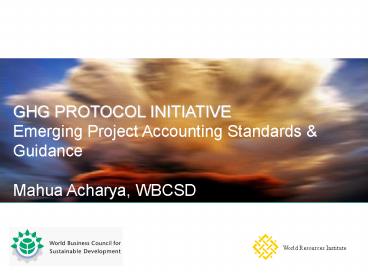GHG PROTOCOL INITIATIVE PowerPoint PPT Presentation
1 / 18
Title: GHG PROTOCOL INITIATIVE
1
GHG PROTOCOL INITIATIVE Emerging Project
Accounting Standards Guidance Mahua Acharya,
WBCSD
2
Project Accounting Standard - Motivation
The absence of clear international accounting
rules for GHG mitigation projects under different
trading programs and initiatives
Setting the scene
3
Purposes of the Project Accounting Standard
- Simplify quantification process while improving
quality credibility - Reduce transaction costs and uncertainty for
project developers - Increase accounting consistency between different
trading programs - Increase investor confidence
Setting the scene
4
What the Project guidelines will cover
- Introduction to GHG project accounting
- GHG project accounting principles their
application - Generic procedure for quantifying project
reductions including baseline selection how to
identify assess secondary effects - Project Typology - project specific guidance for
different project types
Setting the scene
5
What is additionality, why does it matter?
- Criterion to assess and justify whether or not
the GHG reduction would have occurred in the
absence of the project - Additionality is important when a GHG reduction
is used as an offset against a mandatory or
voluntary cap - Environmental integrity
Setting the scene
6
Key steps in project accounting
- 1. Describe project primary reduction(s)
- 2. Check eligibility
- 3. Apply regulatory additionality screen
- 4. Select baseline for primary reduction(s)
- 5. Identify quantify relevant secondary effects
- 6. Estimate project reduction
- 7. Develop Monitoring plan
Setting the scene
7
1. Describe project Typology
- Energy Power
- Industrial Projects
- Fugitive Emissions Capture
- Agricultural Projects
- Carbon Sequestration
Project specific guidance for project developers
regulators
Setting the scene
8
2. Check eligibility
- Different schemes have different rules
- Allowable project types, locations, timing of
project, etc. - Contribute to sustainable development objectives
- Financial additionality financing is additional
to ODA and funding from multi-lateral
organizations - Investment additionality
- Host government approval
Setting the scene
9
3. Apply regulatory screen
- A simple surplus to regulation additionality
screen - Eliminates projects being undertaken to come into
compliance with regulations
Setting the scene
10
4. Select baseline for primary reduction(s)
Guidance provides 2 approaches (emissions
additionality is embedded in each approach) 1.
GHG performance standard (benchmark approach) 2.
Project specific baseline
Setting the scene
11
5. Identify quantify relevant secondary GHG
effects
- Secondary GHG effects include leakage and life
cycle effects - Simple screens help identify any secondary
effects (positive/negative) that can be
reasonably attributable to the project - Guidance on quantifying assessing the relevance
of secondary effects
Setting the scene
12
6. Estimate the GHG reduction
1. Calculates the expected (ex-ante) GHG
reduction 2. Applies an equivalence principle for
project baseline cases 2. Calculates reduction
as the difference between the project and
baseline emissions taking into account any
relevant secondary effects
Setting the scene
13
7. Develop monitoring plan
- Builds on complements baseline selection
procedure assessment of secondary effects - Lists parameters that must be monitored
- Provides calculation sheet for project
Setting the scene
14
Typology provides project specific information
- Issues addressed by Typology include
- Sub-category definitions
- Description of primary reduction
- Eligibility issues
- Secondary effects
- Baseline setting issues
- Monitoring tools
Setting the scene
15
Project Module Timeline
May, 03
June
July
Oct
Apr, 03?
Jan, 03
Task Force work continues
WRI/ WBCSD collates doc
External Review and Road Testing
WRI/ WBCSD external review
Revisions
Release
Printing
16
GHG Protocol Initiative
Thank You www.ghgprotocol.org
Setting the scene
17
Selecting a baseline project specific approach
- 1. Identify possible baseline candidates
- 2. Apply baseline tests to possible baseline
candidiates - barriers assessment
- investment ranking
- 3. Select most likely baseline candidiate
Setting the scene
18
Selecting a baseline GHG performance standard
Establish a performance standard applicable to a
specific category of projects 1. Choose time
period for selecting baseline candidates e.g.
recently constructed sites, or sites under
construction 2. Define geographical area for
selecting candidates 3. Select sample for
constructing performance standard 4. Decide on
level of stringency e.g. average, better than
average, best in class etc. 5. Construct the
performance standard
Setting the scene

